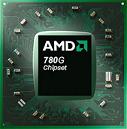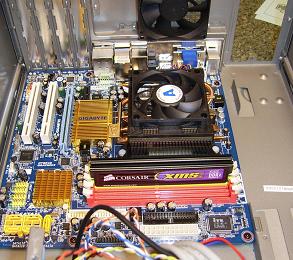|
New AMD 780G Platform and Low Power 4850e Processor

Additional Information:
Lets take a look at the information Vista provides us with about the 4850e and Phenom 9600.
4850e |
Phenom 9600 |
 |
 |
Efficiency:
Enegery Usage was obtained by using a Kill a watt EZ
4850e @ Idle |
4850e Overclocked @ idle |
Phenom 9600 @ Idle |
Phenom 9600 Overclocked @ 100% Load |
The energy usage you see here is for the entire system minus the monitor. As you can see the 4850e is living up to its claims as a low power porcessor. Even with the 4850e overclocked, it was still pulling under 100Watts. Where the Phenom 9600 at idle default speed is registering at 111Watts and over-clocked and underload at 149Watts. These numbers for the phenom are still pretty good. Keep in mind that we are speaking about a M-ATX system that is designed to run low power. The same standard air-cooled heat-sink fan was cooling both processors and was doing a pretty good job of keeping the temp down, though the temperature of the air that was being pushed out was significantly higher and would not be the ideal way of keeping the Phenom cool in a long term scenario.
Gigabyte 780G Platform ?
We have been talking a lot about platforms at TWL lately so its time again to remind everyone about the importance of the platform to the performance of the system as a whole. Gigabyte's GA-MA78GM-S2H, aside from having a really long name, has designed a platform here that we really like. As you can see by the pictures below the board is rather colorful which makes locating ports much easier. We would have liked to see 90degree mounted IDE and SATA ports as we have seen on other boards but realize that this would have likley resulted in a more expensive board and the 780G platform is designed to enter the market at a pricepoint of $80 to $120 with board prices falling slightly afterwards. The GA-MA78GM-S2H motherboard sports HDMI, DVI, and VGA video outputs though only two can be used at a time. As you saw on the first page the 780G specifications call for a single PCIe slot which Gigabyte has in the GA-MA78GM-S2H. With the expanding uses of the PCIe slot we would like to see the addition of a second in future models but this is not likley to happen. Two additional PCI slots are provided for your HDTV tuner, sound card or other expansion card. The really nice benefit of 780G is that as it comes out of the box it includes almost everything you need to get your HTPC started, and all at a low price.
The low power usage of the 4850e processor results in a CPU fan that runs at a slower speed resulting in a nearly silent operation. This is key in a media PC while one is watching a movie or listening to music at a lower volume. No one wants to listen to music while another is vacuuming the room for hours. Also, since the Gigabyte board comes with surround sound built in, the consumer is not looking to spend addional money on sound card for the case. The board also comes with a SPDIF out port which gives you a simple one cable audio to uplink this HTPC to your home theater sound system with ease. With the single cable hook up in mind, the motherboard comes not only a 15pin video and DMI port but also a HDMI port which again gives you an easy plug of video to your HD television or home theater amp.
 |
 |
AMD 4850e:
This is almost a silent roll out of a new processor for AMD. Given the fact that the BE2300, 2350, and 2400 processors became such a favorites and the fact that more and more users find these processors favorable due to their low power consumption and tendancy to overclock well we think AMD should have given a bit more fanfare to the 4850e. Perhaps we are looking at a processor which will be followed up shortly by something that AMD feels will steal the spotlight better? We were introduced to the 4850e in Canada only a few short weeks agoo where and lifted the veil on the 780G and 4850e and showed us some benchmarks as well as gameplay on the new system. We were impressed with the ability to play content, encode, and rip all at the same time without stutter. The new model number reflects intended relative performance while the "e" designnation refers to the processors relatively low TDP and high effeciency. AMD expects consumer availability of the 4850e very shortly with a price tag that will make this processor very attractive at approximately $89.
| PROCESSOR TECH SPECS: | |
| Processor: | Energy efficient AMD AthlonTM X2 4850e Dual-Core Processor |
| OPN: | ADH4850IAA5DO |
| CPU Core Count: | 2 |
| Operating Frequency: | 2.5GHz |
| L1 Cache Size: | 64K - L1 instruction + 64K - L1 data cache per-core (256KB total L1) |
| L2 Cache Size: | 512KB L2 data cache per-core (1MB total dedicated L2 cache) |
| Manufactured: | Fab 36 / Dresden, Germany |
| Process Technology: | 65-nanometer DSL SOI (silicon-on-insulator) technology |
| Packaging: | Socket AM2 (940-pin organic micro PGA) |
| HyperTransport Spec: | One 16-bit/16-bit link @ 2.0GHz (1GHz DDR) full duplex (up to 8.0 GB/sec bandwidth) |
| Memory Controller: | One integrated 128-bit dual-channel memory controller (up to 12.8GB/sec bandwidth) |
| Supported Memory Speeds: | DDR 2 memory up to and including PC2 6400 (DDR2-800) unbuffered |
| Total Processor bandwidth: | Up to 20.8 GB/sec |
| Approximate Transistor count: | 221 million |
| Approximate Die Size: | 118 mm2 |
| Nominal Voltage: | 1.15/1.20/1.25 V |
| Max Thermal Power: | 45W |
| Max Ambient Case Temp: | 78o Celsius |
| Max Processor Current: | 36.5 A |
| Min P-State (power management): | 1.0 GHz |
So essentially for roughly $180 for a motherboard/processor combo you have a platform that is ready to handle light gaming, and any media task you can throw at it.
Test Enclosure:
Since this AMD 4850e is a low wattage processor, and the 780G is designed to be used in an HTPC/Media center PC we decided to drop it into a media case and test its performance as it was designed to be used. The case we selected was the AVC M-1 Media PC case. The AVC M-1 provided the processor with plenty of air flow and there was ample room to install the essentials such as the hard disk, DVD-ROM and a Mini ATX power supply. The system could just as easlily been installed in a standard PC case which would have more room for addiional cards, drives, etc. but the M-1 case was a perfect choice as it's designed to be a HTPC.
See our review of the case here.
Now lets take a look at our test setup.
| « Intel VS AMD | Benchmarks and Performance » |









